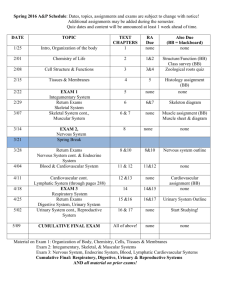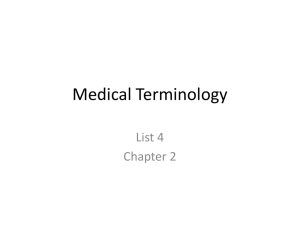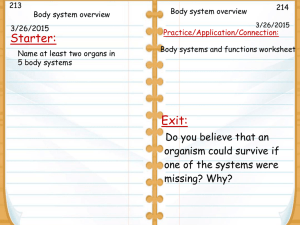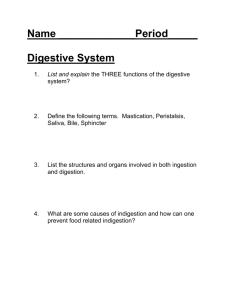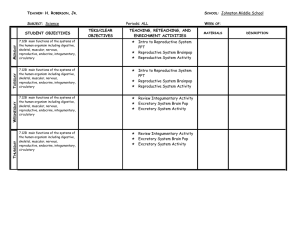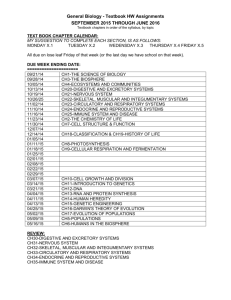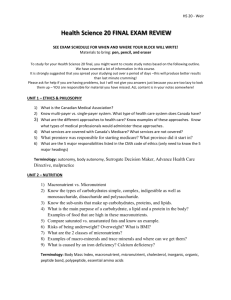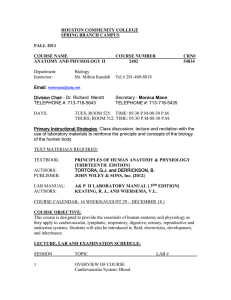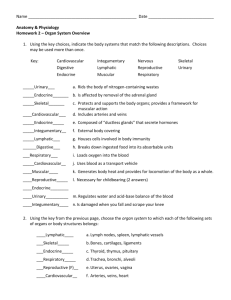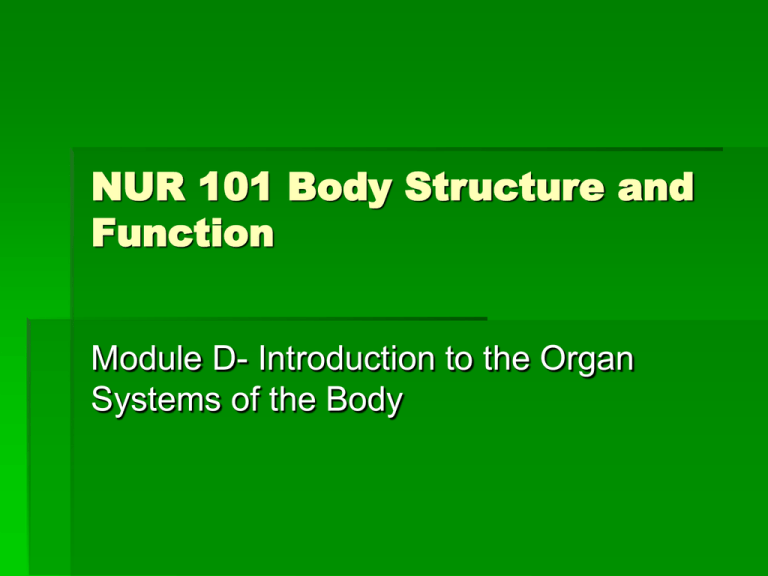
NUR 101 Body Structure and
Function
Module D- Introduction to the Organ
Systems of the Body
Major Organ Systems of the
Body
Integumentary
Skeletal
Muscular
Nervous
Endocrine
Cardiovascular
(circulatory )
Lymphatic
Respiratory
Digestive
Urinary
Reproductive
Integumentary System
Components of the integumentary
system include:
Skin
Hair
Nails
Sense receptors
Sweat glands
Oil glands
Integumentary System
Functions of the Integumentary system:
1. Primary function is protection of
underlying tissue against invasion of bacteria,
most chemical and mechanical injury
2. Regulates body temperature
3. Functions as a sophisticated sense organ
4. Synthesizes important chemicals
Skeletal System
1.
2.
3.
4.
Components of the skeletal system
include:
206 bones
Cartilage
Ligaments
joints
Skeletal System
Functions of the Skeletal system:
1. Provides the body with a rigid framework for
support and protection
2. Makes movement of body parts possible
3. Serve as storage area for important minerals
such as calcium and phosphorus
4. Formation of blood cells in the red marrow of
certain bones
Muscular System
Components of the Muscular system
include:
1. Voluntary or skeletal muscles
2. Involuntary or smooth muscles
3. Cardiac muscle
Muscular System
1.
2.
3.
Functions of the Muscular system:
Provide movement
Maintenance of body posture
Production of heat
Nervous System
1.
2.
3.
4.
Components of the Nervous system
Brain
Spinal cord
Nerves
Sense organs
Nervous System
Functions of the Nervous system:
Communication between body functions
Integration of body functions
Control of body functions
Recognition of sensory stimuli
Control is rapid and short in duration
Endocrine System
Pituitary
Pineal gland
Hypothalamus
Thyroid gland
Parathyroid gland
Thymus
Adrenals
Pancreas
Ovaries
Testes
Endocrine System
Functions of the Endocrine system:
Communication between body functions
Integration of body functions
Control of body functions
Control is slow and long in duration
Hormone regulation of: growth,
metabolism, reproduction, fluid and
electrolyte balance
Cardiovascular System
Components of the Cardiovascular
system :
1. Heart
2. Blood vessels
Cardiovascular System
Functions of the Cardiovascular
system;
Transportation of oxygen, carbon dioxide,
nutrients, hormones and other
substances
Regulates temperature
Defense of the body or immunity
Lymphatic System
Components of the Lymphatic system:
Lymph nodes
Lymph vessels
Thymus
Spleen
Tonsils
Lymphatic System
Functions of the Lymphatic system
Movement of fluids and certain large
molecules from tissue spaces around the
cells
Movement of fat-related nutrients from
the digestive tract to the blood
Involved in the functioning of the immune
system
Respiratory System
Components of the Respiratory
System:
Nose
Pharynx
Larynx
Trachea
Bronchi
Lungs
Respiratory System
Functions of the Respiratory system
The alveoli in the lungs exchange waste
gas (carbon dioxide ) for oxygen
Filtration of irritants from inspired air
Regulation of acid- base balance
Digestive System
Primary Organs
Mouth
Pharynx
Esophagus
Stomach
Small intestine
Large intestine
Rectum
Anal canal
Accessory Organs
Teeth
Salivary glands
Tongue
Liver
Gallbladder
Pancreas
Appendix
Digestive System
Functions of the Digestive system
Mechanical and chemical breakdown of
food
Absorption of nutrients
Undigested waste product is eliminated
through fecal material
Urinary System
Components of the Urinary system
Kidneys
Ureters
Urinary bladder
Urethra
Urinary System
Functions of the Urinary system
Maintains the electrolyte, water, and acidbase balance
Transports urine and semen through the
urethra
Involved in the elimination of waste
products through urine
Reproductive System :
Male
Components of the male reproductive
system
Gonads – Testes
Genital Ducts - Ductus (vas) deferens, Urethra
Accessory organs – Prostate
Genitalia- Penis, Scrotum
Reproductive System :
Female
Components of the female
reproductive system
Gonads- Ovaries
Accessory organs – Uterus, Uterine
(fallopian) tubes, Vagina
Genitalia- Vulva
Mammary glands - Breasts
Reproductive System
Functions of the reproductive system
Ensures survival of the species
Production of hormones permit the
development of sexual characteristics
Transfer and fertilization of sex cells
Development and birth of offspring
Nourishment of offspring


